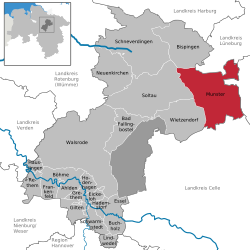Munster (Örtze)
| Munster | ||
|---|---|---|

Water mill in Munster
|
||
|
||
| Coordinates: 52°59′19″N 10°05′28″E / 52.98861°N 10.09111°ECoordinates: 52°59′19″N 10°05′28″E / 52.98861°N 10.09111°E | ||
| Country | Germany | |
| State | Lower Saxony | |
| District | Heidekreis | |
| Government | ||
| • Mayor | Adolf Köthe (Ind.) | |
| Area | ||
| • Total | 193.42 km2 (74.68 sq mi) | |
| Elevation | 73 m (240 ft) | |
| Population (2015-12-31) | ||
| • Total | 15,091 | |
| • Density | 78/km2 (200/sq mi) | |
| Time zone | CET/CEST (UTC+1/+2) | |
| Postal codes | 29633 | |
| Dialling codes | 05192 | |
| Vehicle registration | HK, SFA(outgoing) | |
| Website | www.munster.de | |
Munster, also called Munster (Örtze), is a small town in the district of Heidekreis, in Lower Saxony, Germany almost equidistant from Hamburg and Hanover. The town is home to the German Army's largest garrison and is situated between the two training areas of Munster North and Munster South. It is also the fourth largest garrison in the German Armed Forces. The Bundeswehr Research Institute for Protective Technologies and NBC-Protection is located in Munster.
The town's make up is shaped by the soldiers and other government employees who make up the majority of its population, and the surrounding military zones restrict the town's growth, retaining its rural character.
Munster is situated in the central Lüneburg Heath region along the river Örtze between the towns of Soltau and Uelzen. The Munster military training areas, representing nearly 50% of the city's total area, are reserved for military use. Due to restricted access to the surrounding areas, many rare species and habitats can be found in this region. The region's populations of rare species have been previously drawn upon to restore populations in other regions where such species are endangered.
The first recorded mention of Munster was in 1252. An Imperial German battalion under the command of future President of the German Reich Paul von Hindenburg started the use of this area as a training ground in 1893. The Bundeswehr re-opened its garrison in Munster in 1956 which was expanded in 1990, and again during the transformation process of the Bundeswehr. Today, Munster is the largest garrison of the German Army. Between 1950 - 1984 part of the garrison became a British Army base, Dennis Barracks.
In 1916, the German Empire opened Gasplatz Breloh ("Breloh Gas Facility"), an area dedicated to research in and production of chemical weapons. After World War I, the site was closed and the ammunition stored there was removed. In the process of this removal, a whole train of chemical munitions blew up in 1919, the reasons for this disaster never being uncovered. In 1935, the Third Reich reopened the site as an experimental research and production area as well as a bombing range for chemical ammunitions under the name Heeresnebelfüllstelle Raubkammer ("Army fog-filling plant, Raubkammer"), "fog" being used as a synonym for chemical agents. Over the course of World War II, large quantities of sulphur mustard gas and the new nerve agent, GA, were produced here. At the end of the war, Germany had a continuous production line for GB ready to go online; this plant was dismantled by the British Occupation Forces and later shipped to Porton Down, Great Britain.N
...
Wikipedia



